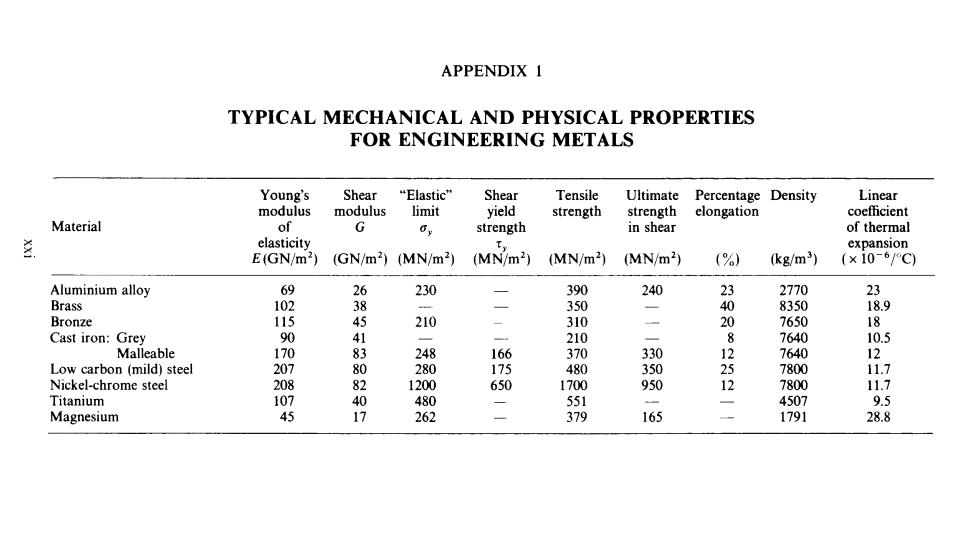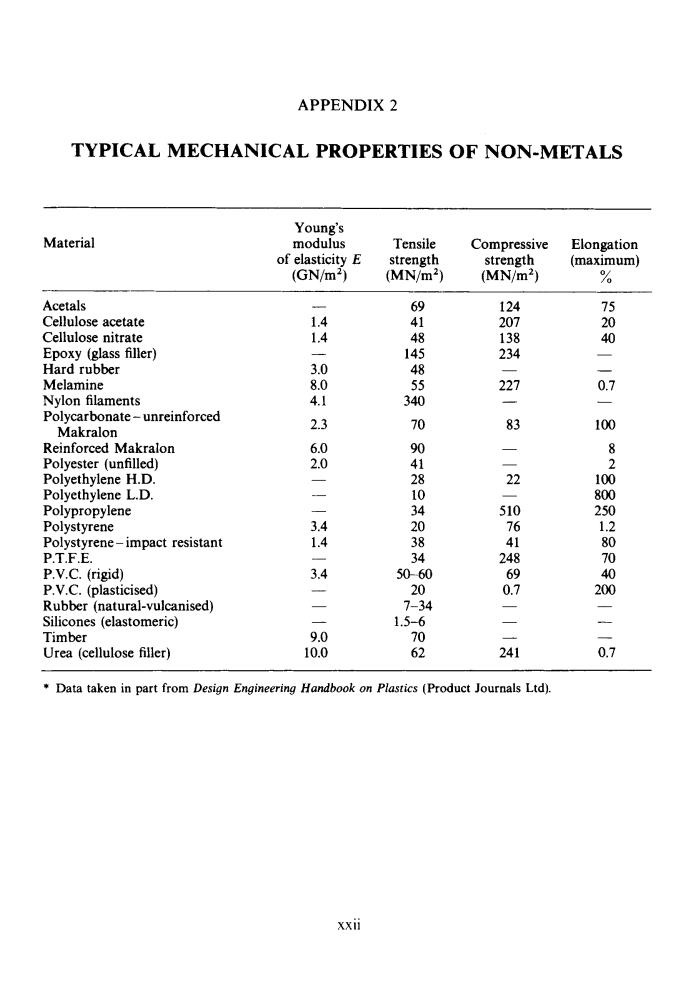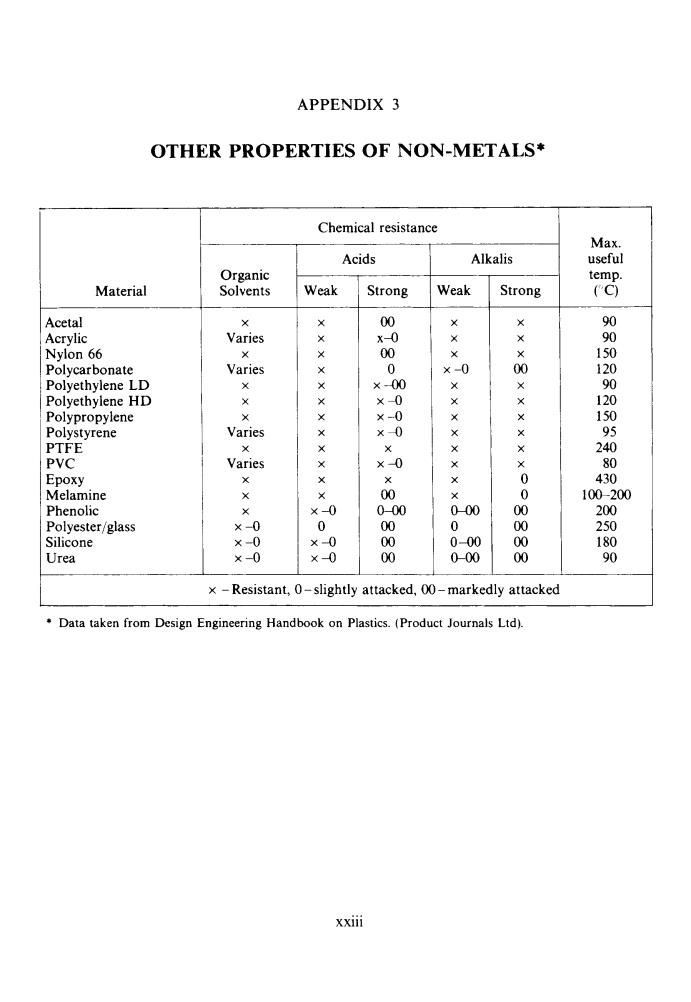
APPENDIX 1 TYPICAL MECHANICAL AND PHYSICAL PROPERTIES FOR ENGINEERING METALS Young's Shear “Elastic'" Shear Tensile Ultimate Percentage Density Linear modulus modulus limit yield strength strength elongation coefficient Material of G Gy strength in shear of thermal elasticity expansion E(GN/m2) (GN/m2) (MN/m2) (MN/m2) (MN/m2) (MN/m2) (%) (kg/m3) (×10-6/PC) Aluminium alloy 69 2 230 390 240 23 2770 23 Brass 102 38 350 0 8350 18.9 Bronze 115 210 310 20 7650 18 Cast iron:Grey 90 210 7640 10.5 Malleable 170 83 248 166 370 330 12 7640 12 Low carbon (mild)steel 207 280 175 480 350 2 7800 11.7 Nickel-chrome steel 208 82 1200 650 1700 950 12 7800 11.7 Titanium 10 480 二 551 4507 9.5 Magnesium 5 17 262 379 165 1791 28.8

APPENDIX 2 TYPICAL MECHANICAL PROPERTIES OF NON-METALS Young's Material modulus Tensile Compressive Elongation of elasticity E strength strength (maximum) (GN/m2) (MN/m2) (MN/m2) % Acetals 69 124 75 Cellulose acetate 1.4 41 207 20 Cellulose nitrate 48 138 40 Epoxy (glass filler) Hard rubber 30 145 234 Melamine 8 5 227 0.7 Nylon filaments 4.1 34 Polycarbonate-unreinforced Makralon 2.3 70 83 100 Reinforced Makralon 6.0 90 二 Polyester (unfilled) 2.0 45810 2 Polyethylene H.D. 22 100 Polyethylene L.D. 800 Polypropylene 510 250 Polystyrene 3.4 2 76 1.2 Polystyrene-impact resistant 1.4 41 80 P.T.F.E. 34 248 70 P.V.C.(rigid) 34 50-60 69 40 P.V.C.(plasticised) 20 0.7 200 Rubber(natural-vulcanised) 7-34 Silicones (elastomeric) 1.5-6 二 Timber 9.0 70 Urea (cellulose filler) 10.0 2 241 0.7 Data taken in part from Design Engineering Handbook on Plastics(Product Journals Ltd). xxii
APPENDIX 2 TYPICAL MECHANICAL PROPERTIES OF NON-METALS Material Young’s modulus Tensile Compressive Elongation of elasticity E strength strength (maximum) (GN/mz) (MN/mz) (MN/mZ) % Acetals Cellulose acetate Cellulose nitrate Epoxy (glass filler) Hard rubber Melamine Nylon filaments Polycarbonate - unreinforced Makralon Reinforced Makralon Polyester (unfilled) Polyethylene H.D. Polyethylene L.D. Polypropylene Polystyrene Polystyrene - impact resistant P.T.F.E. P.V.C. (rigid) P.V.C. (plasticised) Rubber (natural-vulcanised) Silicones (elastomeric) Timber Urea (cellulose filler) - 1.4 1.4 3.0 8.0 4.1 2.3 6.0 2.0 - - 3.4 1.4 3.4 - 9.0 10.0 69 41 48 145 48 55 340 70 90 41 28 10 34 20 38 34 50-60 20 7-34 1.5-6 70 62 1 24 207 138 234 221 - 83 - 22 510 76 41 248 69 0.7 - - 241 75 20 40 - 0.7 100 8 2 100 800 250 1.2 80 70 40 200 - - 0.7 * Data taken in part from Design Engineering Handbook on Plastics (Product Journals Ltd). xxii

APPENDIX 3 OTHER PROPERTIES OF NON-METALS* Chemical resistance Max. Acids Alkalis useful Organic temp. Material Solvents Weak Strong Weak Strong (C) Acetal × + 00 中 + 90 Acrylic Varies + x-0 + + 90 Nylon 66 00 X 150 Polycarbonate Varies × 0 ×-0 N 120 Polyethylene LD X × ×00 90 Polyethylene HD + + ×0 + 120 Polypropylene X ×-0 150 Polystyrene Varies × ×0 95 PTFE × 240 PVC Varies + ×0 80 Epoxy + 430 Melamine X × 00 0 100-200 Phenolic ×0 000 000 00 200 Polyester/glass ×-0 0 00 0 00 250 Silicone ×-0 ×-0 00 0-00 00 180 Urea ×0 ×0 00 0-00 00 90 x-Resistant,0-slightly attacked,00-markedly attacked Data taken from Design Engineering Handbook on Plastics.(Product Journals Ltd). xxiii
APPENDIX 3 OTHER PROPERTIES OF NON-METALS* Material Acetal Acrylic Nylon 66 Polycarbonate Polyethylene LD Polyethylene HD Polypropylene Polystyrene PTFE PVC EPOXY Melamine Phenolic Polyesterjglass Silicone Urea Organic Solvents X Varies Varies X X X X Varies Varies X X X X x -0 x -0 x -0 Chemical resistance Acids Weak X X X X X X X X X X X X X-0 0 X-0 X-0 Strong 00 X-0 00 0 X00 X-0 X-0 X-0 X-0 00 000 00 00 00 X X Alkalis Weak X X X x -0 X X X X X X X X (roo 0 0-00 (Mo Strong X X X 00 X X X X X X 0 0 00 00 00 00 x - Resistant, 0 -slightly attacked, 00 -markedly attacked Max. useful temp. ('C) 90 90 150 120 90 120 150 95 240 80 430 100-200 200 250 180 90 * Data taken from Design Engineering Handbook on Plastics. (Product Journals Ltd). xxiii